Epson ActionPrinter 3000 User Manual
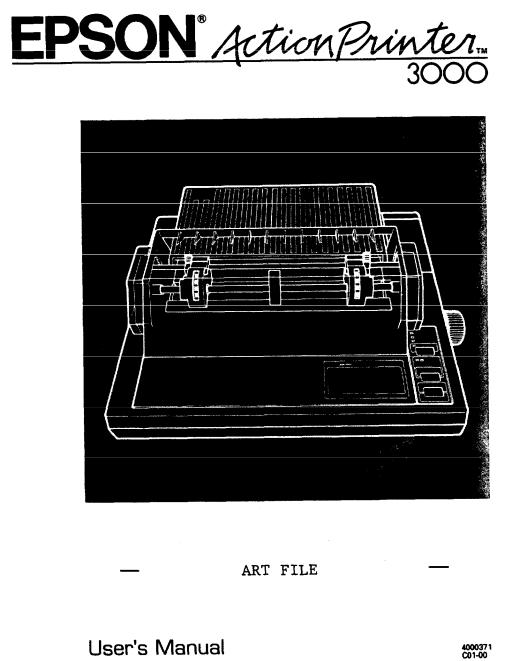
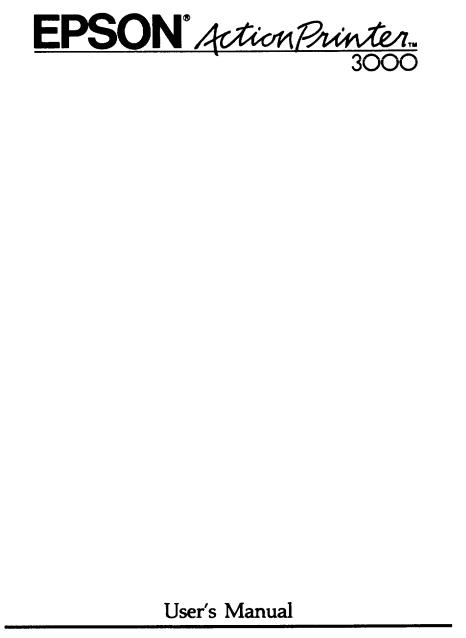

FCC COMPLIANCE STATEMENT FOR AMERICAN USERS
This equipment has been tested and found to comply with the limits for a class B digital device, pursuant to Part 15 of the FCC Rules. These limits are designed to provide reasonable protection against harmful interference in a residential installation. This
equipment generates, uses and can radiate radio frequency energy and, if not installed and |
|
used in accordance with the instructions, may cause harmful interference to radio or |
|
television reception. However, there |
is no guarantee that interference will not occur in a |
particular installation. If this equipment does cause interference to radio and television |
|
reception, which can be determined |
by turning the equipment off and on, the user is |
encouraged to |
try to correct |
the interference by one |
or |
more of the following measures: |
||
. |
Reorient |
or relocate the receiving antenna |
|
|
||
. |
Increase |
the separation |
between the equipment |
and |
receiver |
|
. |
Connect the equipment into an outlet on a circuit different from that to which the |
|||||
|
receiver |
is |
connected |
|
|
|
. |
Consult |
the |
dealer or |
an experienced radio/TV |
technician for help. |
|
WARNING
The connection of a non-shielded equipment interface cable to this equipment will invalidate the FCC Certification of this device and may cause interference levels which
exceed |
the limits established by the FCC for this |
equipment. It is the responsibility of |
the |
user to obtain and use a shielded equipment interface cable with this device. If this |
|
||
equipment has more than one interface connector, do not leave cables connected to |
|
||
unused |
interfaces. |
|
|
Changes or modifications not expressly approved |
by Epson America, Inc., could void |
the |
|
user’s |
authority to operate the equipment. |
|
|
FOR CANADIAN USERS
This digital apparatus does not exceed the Class B limits for radio noise emissions from digital apparatus as set out in the radio interference regulations of the Canadian Department of Communications.
Le présent appareil numerique n'émet pas de bruits radioélectriques dépassant les limites applicables aux appareils numériques de Classe B prescrites dans le règlement sur le brouillage radioeléctriques édicté par le Ministère des Communications du Canada.
All rights reserved. No part of this publication may be reproduced, stored in a retrieval system, or transmitted in any form or by any means, mechanical, photocopying,
recording, or otherwise, without the prior written |
permission of Epson America, Inc. No |
patent liability is assumed with respect to the use |
of information contained herein. While |
every precaution has been taken in the preparation of this book, Epson America, Inc. assumes no responsibility for errors or omissions. Neither is any liability assumed for damages resulting from the use of information contained herein.
Epson America, Inc. shall not be liable against any damages arising from the use of any options other than those designated as Original Epson Products by Seiko Epson Corporation.
Epson and Epson ESC/P are registered trademarks of Seiko Epson Corporation.
General Notice: Other |
product |
names |
used herein are for identification purposes only and |
|
may be trademarks of their respective companies. |
||||
Copyright |
© 1991 by |
Epson |
America, |
Inc. |
Torrance, |
California |
|
|
|
ii

IMPORTANT SAFETY INSTRUCTIONS
1.Read all of these instructions and save them for later reference.
2.Follow all warnings and instructions marked on the product.
3.Unplug this product from the wall outlet before cleaning. Do not use liquid cleaners or aerosol cleaners. Use a damp cloth for cleaning.
4.Do not use this product near water.
5.Do not place this product on an unstable cart, stand, or table. The product may fall, causing serious damage to the product.
6.Slots and openings in the cabinet and the back or bottom are provided for ventilation; to ensure reliable operation of the product and to protect it from overheating, these openings must not be blocked or covered. The openings should never be blocked by placing the product on a bed, sofa, rug, or other similar surface. This product should never be placed near or over a radiator or heat register. This product should not be placed in a built-in installation unless proper ventilation is provided.
7.This product should be operated from the type of power source indicated on the marking label. If you are not sure of the type of power available, consult your dealer or local power company.
8.This product is equipped with a 3-wire grounding-type plug, a plug having a third (grounding) pin. This plug will only fit into a grounding-type power outlet. This is a safety feature. If you are unable to insert the plug into the outlet, contact your electrician to replace your obsolete outlet. Do not defeat the purpose of the grounding-type plug.
9.Do not locate this product where the cord will be walked on.
i i i

10.If an extension cord is used with this product, make sure that the total of the ampere ratings on the products plugged into the extension cord do not exceed the extension cord ampere rating. Also, make sure that the total of all products plugged into the wall outlet does not exceed 15 amperes.
11.Never push objects of any kind into this product through cabinet slots, as they may touch dangerous voltage points or short out parts that could result in a risk of fire or electric shock. Never spill liquid of any kind on the product.
12.Except as specifically explained in the User’s Manual, do not attempt to service this product yourself. Opening or removing those covers that are marked “Do Not Remove” may expose you to dangerous voltage points or other risks. Refer all servicing in those compartments to service personnel.
13.Unplug this product from the wall outlet and refer servicing to qualified service personnel under the following conditions:
A.When the power cord or plug is damaged or frayed.
B.If liquid has been spilled into the product.
C.If the product has been exposed to rain or water.
D.If the product does not operate normally when the operating instructions are followed. Adjust only those controls that are covered by the operating instructions, since improper adjustment of other controls may result in damage and will often require extensive work by a qualified technician to restore the product to normal operation.
E.If the product has been dropped or the cabinet has been damaged.
F.If the product exhibits a distinct change in performance, indicating a need for service.
iv
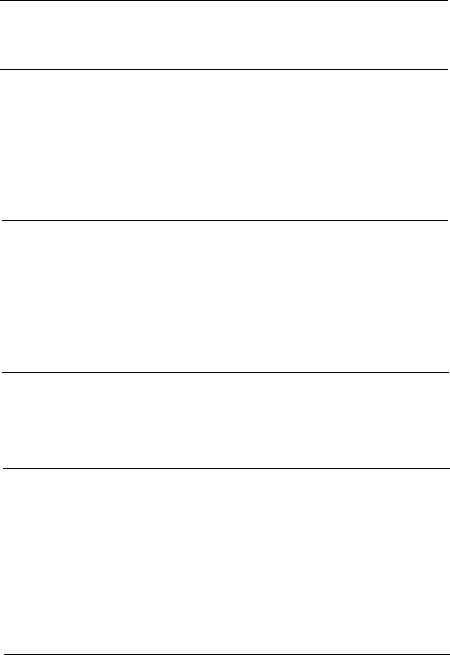
Contents |
|
Introduction |
1 |
Features ..................................................................... |
1 |
Options ..................................................................... |
1 |
Finding Your Way Around ............................................ |
2 |
Warnings, Cautions, and Notes ...................................... |
2 |
Name of the Parts ....................................................... |
3 |
Where to Get Help ...................................................... |
4 |
Chapter 1 Setting Up the Printer |
1-1 |
Unpacking the Printer ................................................ |
1-2 |
Choosing a Place for the Printer .................................. |
1-4 |
Assembling the Printer ............................................... |
1-6 |
Testing the Printer .................................................... |
1-10 |
Connecting the Printer to Your Computer ..................... |
1-19 |
Setting Up Your Application Software .......................... |
1-21 |
Chapter 2 Paper Handling |
2-1 |
Using Single Sheets ................................................... |
2-2 |
Using Continuous Paper ............................................. |
2-6 |
Printing on Special Paper ........................................... |
2-14 |
Chapter 3 Using the Printer |
3-1 |
Operating the Control Panel ....................................... |
3-2 |
Setting the DIP Switches ............................................ |
3-5 |
Selecting Typestyles ................................................... |
3-12 |
Selecting an International Character Set ........................ |
3-16 |
Choosing a Character Table ........................................ |
3-17 |
Data Dump Mode ..................................................... |
3-19 |
Contents v

Chapter 4 Using the Printer Options |
4-1 |
Cut-Sheet Feeder.. . . . . . . . . . . . . . . . . . . . . . . . . . . . . . . . . . . . . . . . . . . . . . . . . . . . . . |
4-2 |
|
|||
Film Ribbon . . . . . . . . . . . . . . . . . . . . . . . . . . . . . . . . . . |
. . . . . . . . . . . . . . . . . . . . ...... 4-8 |
|
|||
Chapter 5 Maintenance and Transportation |
5-1 |
|
|||
Cleaning the Printer .................................................. |
|
5-2 |
|
||
Replacing the Ribbon ................................................. |
|
5-3 |
|
||
Transporting the Printer ............................................. |
|
5-4 |
|
||
Chapter 6 Troubleshooting |
|
6-1 |
|
||
Problems and Solutions .............................................. |
|
6-2 |
|
||
Power Supply .......................................................... |
|
6-3 |
|
||
Printing ................................................................... |
|
6-4 |
|
||
Paper Handling ........................................................ |
|
6-8 |
|
||
Options ................................................................... |
|
6-10 |
|
||
|
Chapter 7 Technical Specifications |
|
7-1 |
|
|
Printer Specifications ................................................. |
|
7-2 |
|
||
|
Interface Specifications ............................................... |
|
7-8 |
|
|
|
Initialization ............................................................. |
|
7-12 |
|
|
|
Chapter 8 Command Summary |
|
8-1 |
|
|
|
Using the Command Summary . . . . . . . . . |
. . . . . . . . . . . . . . . . . . . . . . . . . . |
. 8-2 |
|
|
|
Commands Arranged by Topic . . . . . . . . . |
. . . . . . . . . . . . . . . . . . . . . . . . . . |
. 8-3 |
|
|
|
Appendix |
|
A-1 |
|
|
|
Character Tables . . . . . . . . . . . . . . . . . . . . . . . . . . . . . |
. . . . . . . . . . . . . . . . . . . . . . . . . |
A-2 |
|
|
|
Glossary |
|
GL-1 |
|
|
|
|
|
|
|
|
|
Index |
|
IN-1 |
|
|
vi Contents
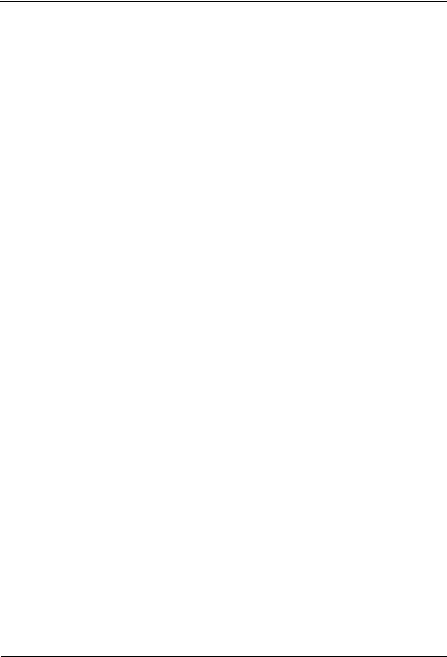
Introduction
Your new Epson 24-pin dot matrix printer combines a compact design and high performance with a wide range of features.
Features
In addition to the high-quality printing and ease of operation you have come to expect from Epson printers, your printer offers the following:
•Easy paper handling, featuring automatic single sheet loading
•Fast draft mode printing of up to 192 characters per second at 12 cpi
•Seven built-in Letter Quality fonts for producing high-quality documents
•A convenient control panel design that allows direct selection of fonts
•Two paper slots (rear and bottom) for using a variety of paper types
•Compatibility with the Epson ESC/P® commands used by other Epson LQ printers.
Options
You may choose a cut-sheet feeder or a film ribbon to enhance use of your printer. For information on these options, see Chapter 4.
•Single-bin Cut-Sheet Feeder ( # 7341)
The cut-sheet feeder gives you easier and more efficient handling of single-sheet paper. It automatically feeds up to 100 sheets of standard bond paper into the printer.
Introduction 1

Introduction
•Film Ribbon Cartridge ( # 7768)
An optional film ribbon cartridge provides you with even higher quality printing than the standard fabric ribbon.
Finding Your Way Around
This manual provides fully illustrated, step-by-step instructions for setting up and operating your printer.
•Chapter 1 contains information on unpacking, setting up, testing, and connecting the printer. Be sure to read this chapter first.
•Chapters 2 and 3 include important information on paper handling and day-to-day operation of your printer.
•Chapter 6 contains troubleshooting information. If the printer does not operate properly or the printed results are not what you expect, see Chapter 6 for a list of problems and solutions.
•Other chapters contain information on general maintenance, specifications, and printer commands. There is also a glossary of printer terms and an index.
Warnings, Cautions, and Notes
WARNINGS must be followed to avoid bodily injury.
CAUTIONS must be observed to avoid damage to your equipment.
Notes contain important information and useful tips on the operation of your printer.
2 Introduction
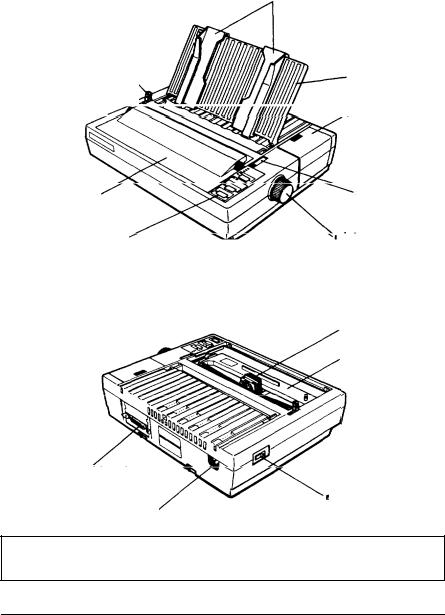
Name of the Parts
paper release lever
printer cover
control panel
parallel interface
AC inlet
Introduction
edge guides
paper guide
compartment cover
slot cover
platen knob
print head
ribbon cartridge
power switch
Note: In some locations, the power cord is attached to the printer.
Introduction 3

Introduction
Where to Get Help
A network of authorized Epson Customer Care Centers throughout the United States offers customer support and service for Epson products. Epson America provides product information and support to its dealers and Customer Care Centers.
Call the Epson Consumer Information Center at 1-213-782-2606 for the following referrals:
•Your nearest Epson dealer
•The nearest Customer Care Center for parts and service
•Technical assistance.
4 Introduction
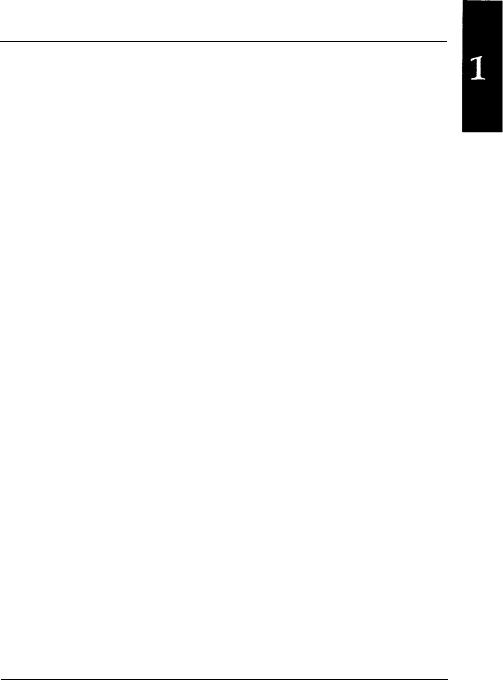
Chapter 1
Setting Up the Printer
Unpacking the Printer . . . . . . . . . . . . . . . . . . . . . . . . . . . . . . . . . . . . . . . . . . . . . . . . . 1-2
Choosing a Place for the Printer . . . . . . . . . . . . . . . . . . . . . . . . . . . . . . . . . . . 1-4
Assembling the Printer ................................................ |
1-6 |
Installing the platen knob ......................................... |
1-6 |
Installing the ribbon cartridge .................................... |
1-6 |
Testing the Printer ..................................................... |
1-10 |
Plugging in the printer ............................................. |
1-10 |
Loading paper ......................................................... |
1-11 |
Running the self test ................................................ |
1-17 |
Connecting the Printer to Your Computer ...................... |
1-19 |
The parallel interface ............................................... |
1-19 |
Setting Up Your Application Software ........................... |
1-21 |
Choosing from a menu ............................................ |
1-21 |
Setting Up the Printer |
1-1 |
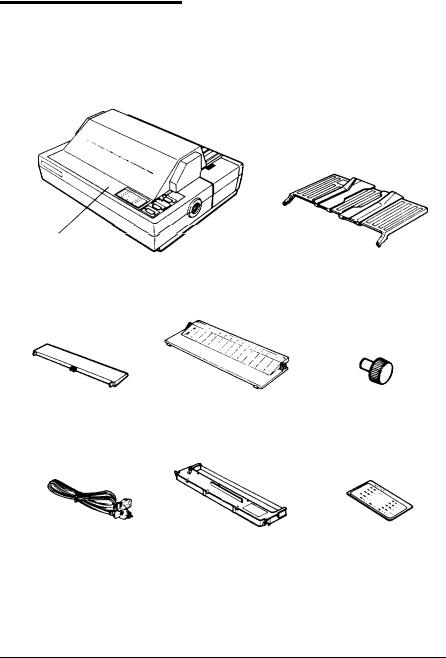
Unpacking the Printer
When you unpack the printer, make sure that you have all the parts shown below and that none has been damaged.
tractor cover
paper guide
printer
paper rest |
printer cover |
platen knob |
power cord |
ribbon cartridge |
Selec Type sticker |
1-2 Setting Up the Printer
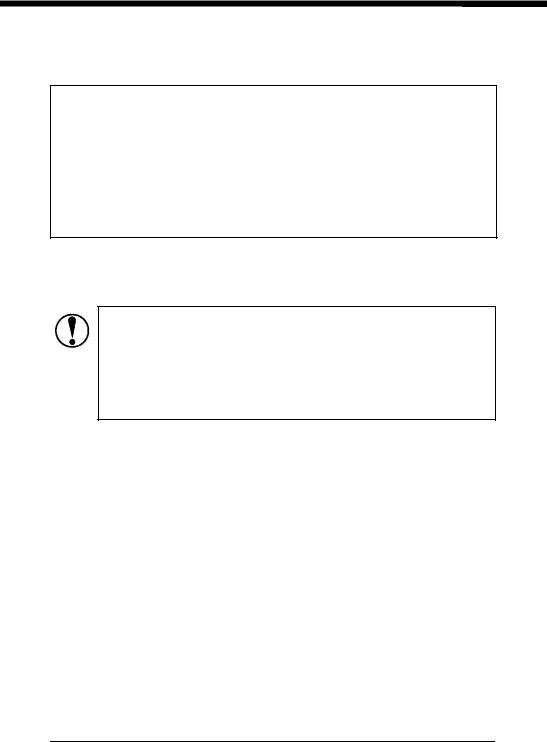
Unpacking the Printer
Note:
•You’ll find the platen knob in a piece of the foam packing.
•You’ll find the SelecType sticker inside the user’s manual. This sticker is a useful reference for selecting fonts with the control panel. You can put this sticker on either the printer cover or the front cover provided with the optional cut-sheet feeder.
•In some locations, the power cord is attached to the printer.
After removing the parts, store the packing materials in case you ever need to transport your printer.
CAUTION: There are several different versions of the printer designed for different electrical standards. It is not possible to adjust the printer for use at another voltage. The power supply type is shown on the label on the back of the printer. If it does not show the correct voltage for your country, contact your dealer.
Setting Up the Printer |
1-3 |
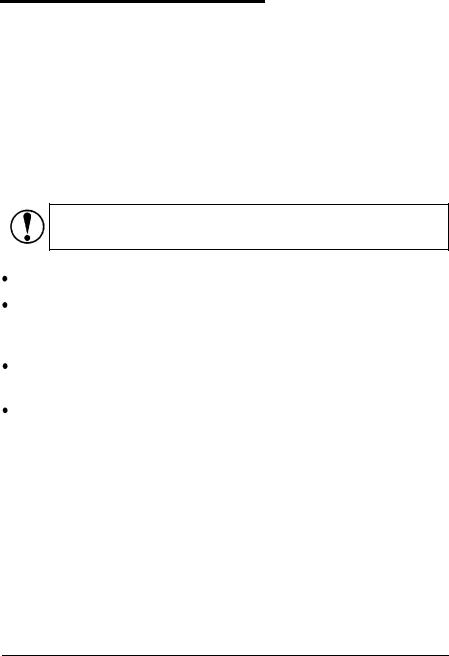
Choosing a Place for the Printer
When selecting a place to set up your printer, be sure to keep the following in mind:
•Place the printer on a flat, stable surface.
•Place the printer close enough to the computer for the printer cable to reach.
•Leave adequate room around the printer to allow for easy operation and maintenance.
CAUTION: Avoid locations that are subject to direct sunlight, excessive heat, moisture, or dust.
Use a grounded outlet; do not use an adapter plug.
Avoid electrical outlets controlled by wall switches or automatic timers. Accidental disruption of power can wipe out information in the memory of your computer or your printer.
Avoid outlets on the same circuit with large motors or other appliances that might cause fluctuations in line voltage.
Keep the entire computer system away from potential sources of electromagnetic interference such as loudspeakers or the base units of cordless telephones.
1-4 Setting Up the Printer
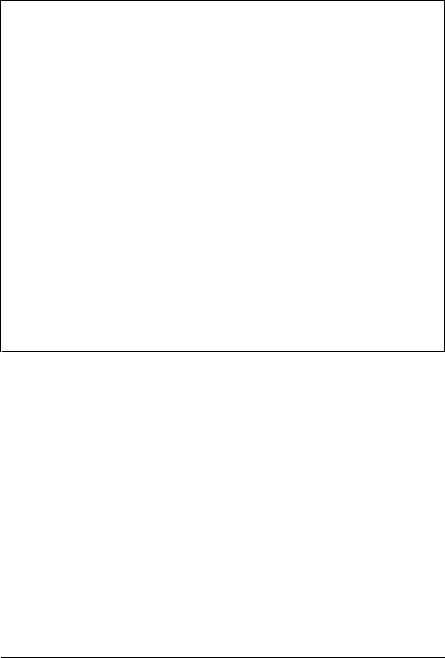
Choosing a Place for the Printer
Note: If you plan to use a printer stand, follow these guidelines:
•Use a stand that supports at least 30 lbs (14 kg), which is twice the weight of the printer.
•Never use a stand that tilts the printer at an angle of more than 15 degrees from horizontal. If you install a cut-sheet feeder, keep your printer absolutely level.
•If you position the paper supply below the printer stand, make sure that you allow enough clearance (one inch or 25 mm) to keep the paper from catching on the underside of the stand. Also see that the distance between the stands supports is at least 11 inches (280 mm), to accommodate any paper size you may use.
•Position your printer’s power cord and interface cable so that they do not interfere with paper feeding. If possible, secure the cables to the printer stand.
•Position the paper stack even with the pull-tractor sprocket units, so that the paper has a straight path into the printer.
Setting Up the Printer |
1-5 |
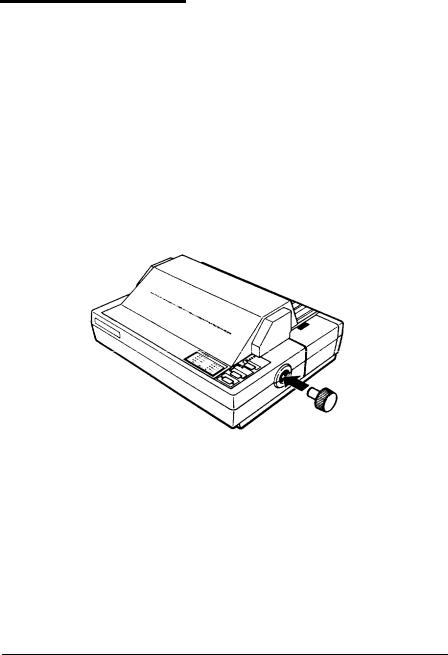
Assembling the Printer
After choosing a good place for your printer, you install the platen knob.
Installing the platen knob
You use the platen knob to manually feed paper in the printer when the printer is turned off. You find the platen knob packed in an indentation in the white foam packing material.
1.Insert the knob into the hole on the printer’s side and rotate it until it slips onto the shaft.
2. Push firmly on the knob until it fits against the printer case.
Installing the ribbon cartridge
Before installing the ribbon cartridge, make sure that the printer is not plugged into an electrical outlet.
1-6 Setting Up the Printer

Assembling the Printer
1. Raise the tractor cover to the upright position. Then lift the cover up and off.
Note: Remove the packing material inserted between both sides of the tractor unit and the tractor cover. Be sure to store this material with the other packing materials.
CAUTION: Never move the print head while the printer is turned on because this can damage the printer. Also, if you just used the printer, the print head may be hot; let it cool for a few minutes before touching it.
2. Slide the print head to the middle of the printer.
Setting Up the Printer |
1-7 |
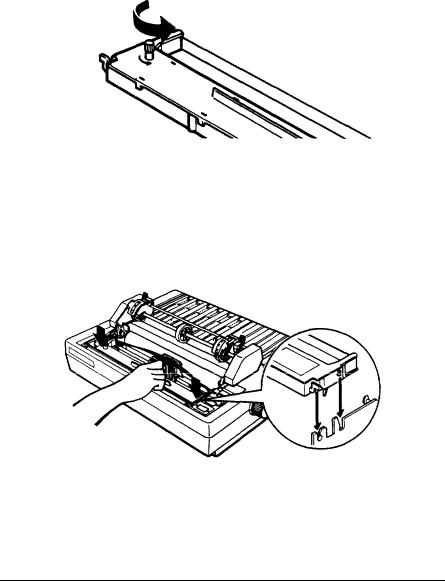
Assembling the Printer
3.Turn the ribbon-tightening knob in the direction of the arrow. This removes any slack in the ribbon to make it easier to install.
4.Hold the ribbon cartridge by its handle and push it firmly down into position, making sure the plastic hooks fit into the slots.
Press lightly on both ends of the cartridge to be sure the hooks are properly seated.
1-8 Setting Up the Printer
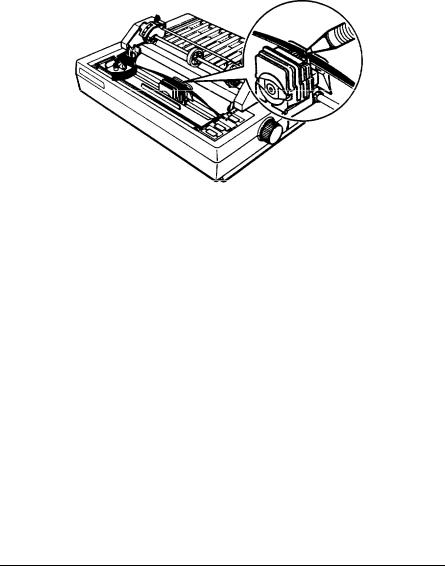
Assembling the Printer
5.Use a pointed object, such as a ball point pen, to guide the ribbon between the print head and ribbon guide while you turn the ribbon-tightening knob to help feed the ribbon into place.
6.Slide the print head from side to side to be sure it moves smoothly. Also see that the ribbon is not twisted or creased.
Setting Up the Printer |
1-9 |
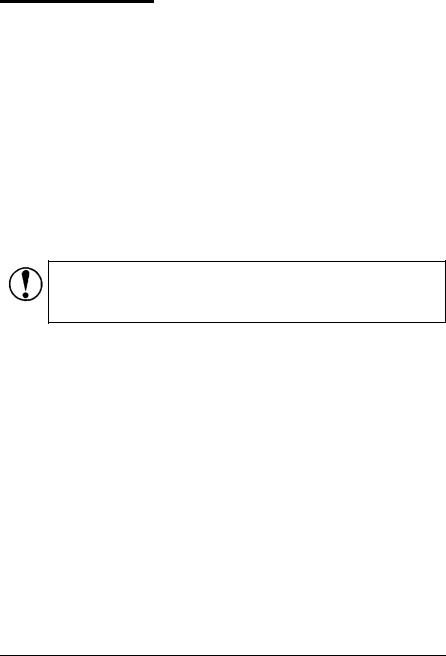
Testing the Printer
Before connecting your printer to a computer, you use the built-in self-test function to see that the printer is working properly.
Before running the self test, you need to connect your printer to an electrical outlet and load paper.
Plugging in the printer
1.Make sure the printer is turned off.
2.Check the label on the back of the printer to make sure the power rating required by the printer matches that of your electrical outlet.
CAUTION: If the rated voltage and your outlet voltage do not match, contact your dealer for assistance. Do not plug in the power cord.
3.If the power cord is not attached to the printer, connect it to the AC inlet on the printer’s rear panel.
4.Plug the power cord into a properly grounded electrical outlet.
1-10 Setting Up the Printer
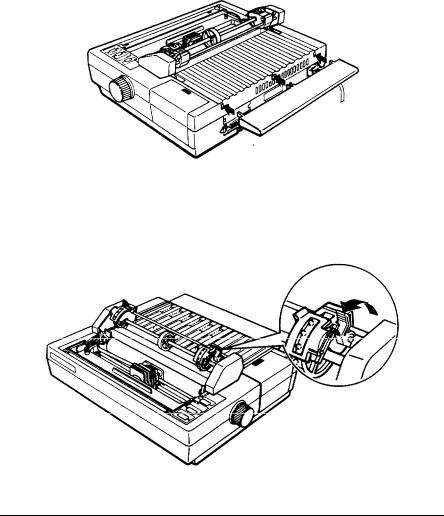
Testing the Printer
Loading paper
Next, you need to load paper. This section describes loading continuous paper. If you wish to use single sheets, see the section on using single sheets in Chapter 2.
1.Make sure the printer is turned off and that the paper release lever is in the continuous paper position. Attach the paper rest.
2.Slide the print head to the middle of the printer.
3.Release the sprocket units by pulling the sprocket locks forward.
Setting Up the Printer |
1-11 |
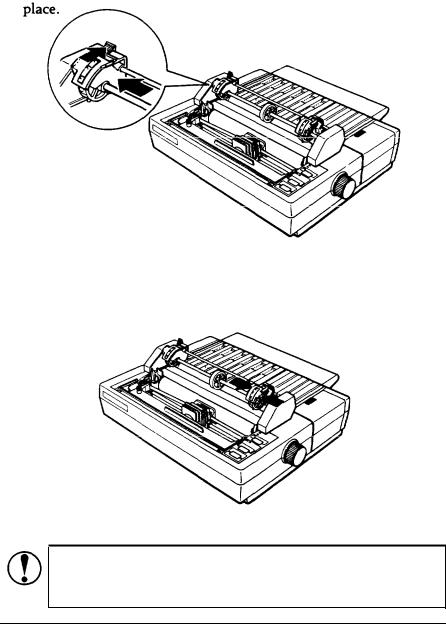
Testing the Printer
 Slide the left sprocket unit to approximately 0.5 inches (12 mm) from the far left position and push the lever back to lock it in
Slide the left sprocket unit to approximately 0.5 inches (12 mm) from the far left position and push the lever back to lock it in
5.Slide the right sprocket unit to match the width of your paper, but do not lock it.
CAUTION: Use continuous paper wider than 8 inches (200 mm) for the self test; otherwise, the print head will print directly onto the platen, possibly damaging it.
1-12 Setting Up the Printer

Testing the Printer
6.Position the paper support midway between the two sprocket units.
7. Open both sprocket covers.
Setting Up the Printer |
1-13 |
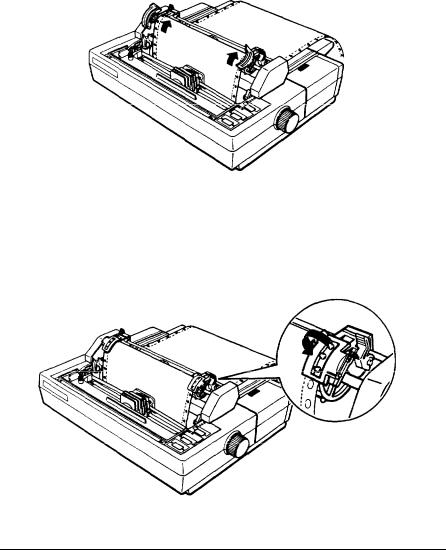
Testing the Printer
8.Make sure your paper has a clean, straight edge and then insert the paper into the printer until it emerges between the platen and the ribbon guide. Pull it up to the sprocket units.
9.Fit the holes of the paper over the tractor pins of the sprocket units, and then close the sprocket covers.
1-14 Setting Up the Printer
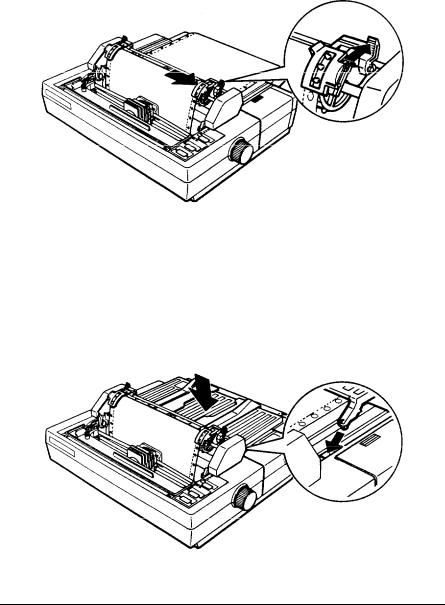
Testing the Printer
10.Slide the right sprocket unit to a position where the paper is straight and not wrinkled; then lock it in place.
11.If there is slack in the paper between the print head and the tractor unit, use the platen knob to take up the slack.
12.To separate the incoming paper from the outgoing printed paper, attach the paper guide in its flat position over the printer and incoming paper.
Setting Up the Printer |
1-15 |
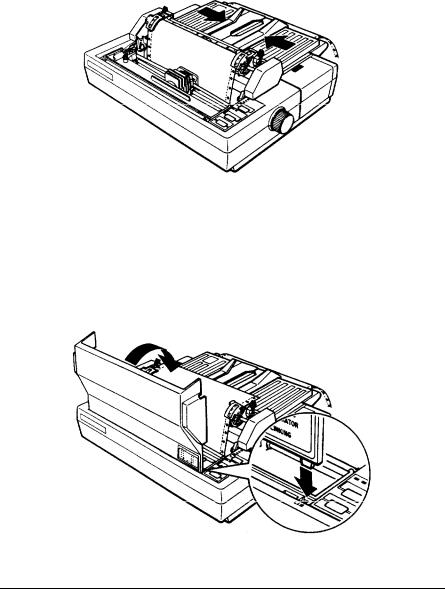
Testing the Printer
13. Slide the edge guides to the center of the paper’s width.
14.Use the platen knob to feed the paper until its perforation is just about even with the top of the ribbon.
15.Attach and close the tractor cover.
1-16 Setting Up the Printer
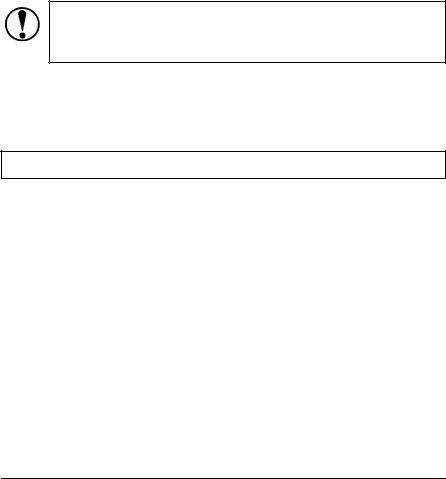
Testing the Printer
Running the self test
The self test runs in draft mode or Letter Quality (LQ) mode, depending upon which button you hold down as you turn on the printer.
1.Make sure the printer is turned off and paper is loaded.
2.While holding down the LINE FEED button (draft mode) or the FORM FEED button (LQ mode), turn on the printer. After printing starts, release the button.
CAUTION: After turning the printer off, always wait at least five seconds before turning it back on. Turning the power on and off rapidly can damage the printer.
3.The self test continues until the paper runs out or you press the ON LINE button. When you wish to. stop the test, press the ON LINE button.
Note: To resume the test, press the ON LINE button again.
Setting Up the Printer |
1-17 |

Testing the Printer
4.To end the self test, be sure the printer is not printing. Press the FORM FEED button to feed the paper forward and tear it off at the perforation. Then turn off the printer.
Here is part of a typical self test printed in Letter Quality mode.
Note: If the self test did not print satisfactorily, see Chapter 6.
1-18 Setting Up the Printer
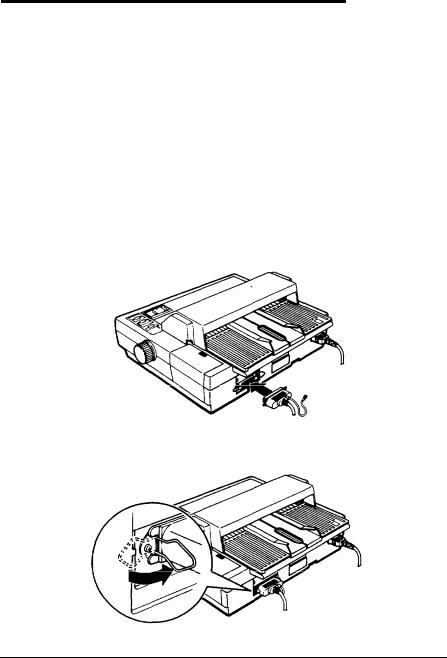
Connecting the Printer to Your Computer
If the self test printed correctly, you are ready to connect your printer to the computer. Most computers have a parallel interface. Check your computer’s operating manual, if you are in doubt about your computer’s interface. If it is parallel, use a suitable shielded cable to connect your computer to your printer’s built-in parallel interface, as described in the next section.
The parallel interface
Connect the parallel interface cable as described below:
1.Make sure both the printer and computer are turned off; then plug the cable connector securely into the printer.
2.Squeeze the wire clips together until they lock in place on either side of the connector.
Setting Up the Printer |
1-19 |
